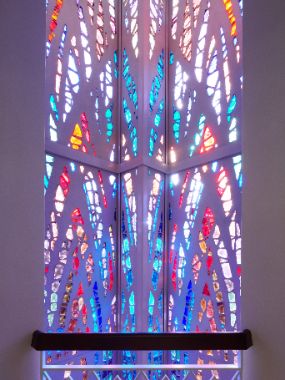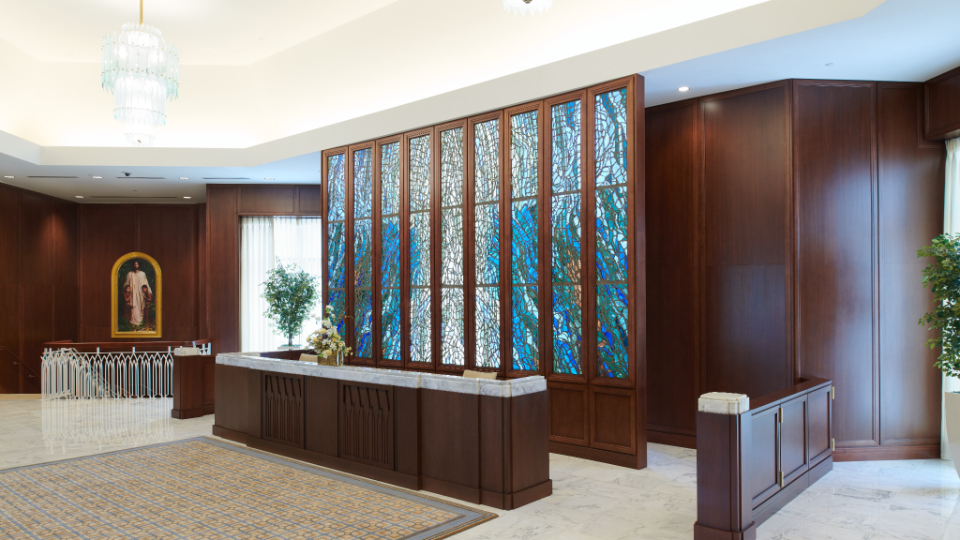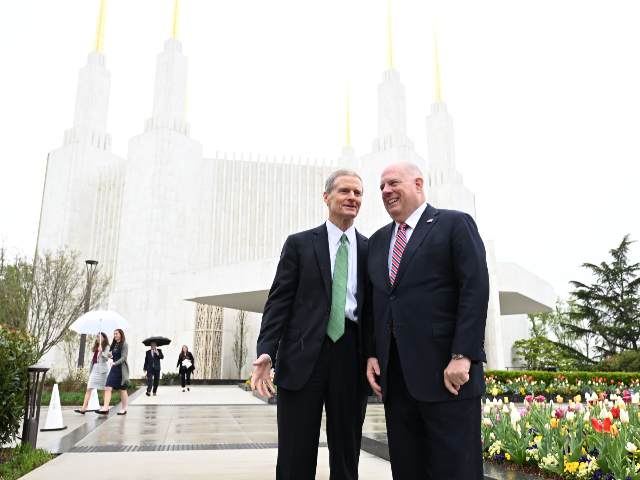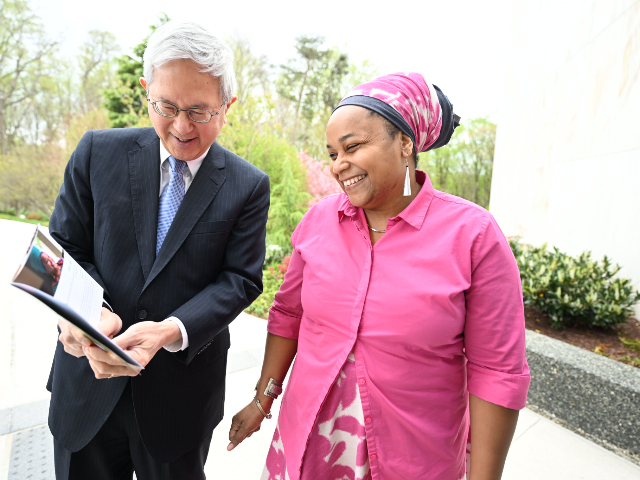William Randall Cone had recently returned from San Francisco, worldly wise and somewhat jaded toward religion, when he accepted an invitation from his brother to help build the Washington D.C. Temple in the 1970s.
It was then, working on a team full of former missionaries of The Church of Jesus Christ of Latter-day Saints, that Cone’s interest was piqued in his brother’s faith. “These construction workers I was working with were terrific people,” Cone said. “They were fascinating. They were interesting. They were funny. But they were always honest. I mean, who’s always honest? It was amazing. And I thought, ‘Who wouldn’t want to be like this? How are they this way?’”
(By downloading content you agree to only use the content in accordance with Church’s Terms of Use.)
Downloadable High-Resolution Images
-
- Washington-D.C.-Temple-exterior
- Washington-DC-Temple-Reception-Desk
- Washington-DC-Temple-Bridge
- Washington-D.C.-Temple-bridge
- Washington-DC-Temple-Rotunda
- Washington-DC-Temple-Rotunda-Painting
- Washington-DC-Temple-Rotunda
- Washington-DC-Temple-Instruction-Room
- Washington-DC-Temple-Brides-Room
- Washington-D.C.-Temple-baptistry
- Washington-DC-Temple-baptistry-oxen
- Washington-DC-Temple-stained-glass-windows
- Washington-DC-Temple-Sitting-Area
- Washington-DC-Temple-stairs
- Washington-DC-Temple-Celestial-Room
- Washington-DC-Temple-Celestial-Room
- Washington-DC-Temple-Celestial-Room
- Washington-DC-Temple-assembly-hall
- Washington-DC-Temple-escutheons-
- Washington-DC-Temple-sealing-room
- Washington-DC-Temple-chapel
- Sylacauga,-Alabama-quarry.jpg
- Washington-DC-Temple-aerial-view
- Washington-DC-Temple-artists-rendering
- Washington-DC-Temple-original-design-plans
- Washington-DC-Temple-construction-
- Washington-DC-Temple-construction
- Washington-DC-Temple-exterior-
- Washington-DC-Temple-original-design-plans
- Washington-DC-Temple-site-plans
- Washington-DC-Temple-construction
- Washington-DC-Temple-original-floor-plans
- Washington-DC-Temple-artist-rendering
- Washington-DC-Temple-architects
- Washington-DC-Temple-artist-rendering
- Washington-DC-Temple-artist-rendering
- Washington-DC-Temple-construction
- Washington-DC-Temple-exterior-bronze-door
- Washington-DC-Temple-gardens
- Washington-DC-Temple-exterior
| Temple Square is always beautiful in the springtime. Gardeners work to prepare the ground for General Conference. © 2012 Intellectual Reserve, Inc. All rights reserved. | 1 / 2 |
Temple press kit: English, French, Portuguese and Spanish
Cone, who had explored other religions in depth, began reading the Book of Mormon and meditating. He had spiritual experiences that motivated him to change his ways and join the Church.
Cone said life only became more difficult after he became a Latter-day Saint. His father and mother died. His business struggled.
“And yet,” he adds, “I was blessed beyond measure. I was given the tools — and they’re here in [the Washington D.C. Temple] — to deal ethically and virtuously with every circumstance that this world can throw at you.”
Now, more than four decades later, Cone is rejoicing with other Latter-day Saints as the house of the Lord he helped build reopens after a major renovation and an extended open house delay due to COVID-19.
The Open House and Temple Rededication
Those coming to the Washington D.C. Temple open house should understand that Latter-day Saints consider temples to be the most sacred space in the world. Ceremonies in each temple teach the purpose of life and unite families, past and present. The mere presence of temples in communities around the globe reminds Latter-day Saints of the importance of having faith in the common Father of all humanity, the need for constant improvement of the soul, the possibility of family relationships that reach beyond the grave, and the salvation that comes only through the grace of Jesus Christ.
The Washington D.C. Temple open house will begin with private tours for invited guests from April 19 to April 27. A public open house will start on April 28 and extend for several months (excluding Sundays). Open house ticket information is available at dctemple.org.
The temple rededication will take place on Sunday, August 14 2022, in three sessions: at 10 a.m., 1:30 p.m., and 5 p.m. Based on current information, those who attend any of the three sessions of the rededication in the temple are required to wear a face mask.
President Russell M. Nelson will dedicate the temple. The following leaders will also participate in the dedication: President Dallin H. Oaks and President Henry B. Eyring of the First Presidency; Elders Quentin L. Cook, D. Todd Christofferson and Gerrit W. Gong of the Quorum of the Twelve Apostles; Presiding Bishop Gérald Caussé; Elder Paul V. Johnson of the Presidency of the Seventy; Sister Amy A. Wright of the Primary General Presidency; and Elders W. Mark Bassett, Kevin R. Duncan, Allen D. Haynie and Vai Sikahema of the Seventy.

53190db4f09b11eba12ceeeeac1e05fae503978f.jpeg
A stained glass wall inside the Washington D.C. Temple, July 2021.2022 by Intellectual Reserve, Inc. All rights reserved.What Was Renovated?
The temple first opened in 1974 and closed in March 2018 for a significant renovation. Energy-efficient mechanical, electrical and lighting systems throughout the 160,000-square-foot structure have been installed, as has new plumbing.
Dan Holt, project manager for the Washington D.C. Temple renovation project, said the intent was to “bring the building back to its original glory” as a midcentury modern structure. A gothic arch motif that directs eyes heavenward is prevalent throughout — in altars, carpeting, gold leafing and the reframed stained glass windows (now backlit with LED lights for more prominence) on the east and west of the temple. The windows’ colors become lighter as they near the spire. This design, Holt said, signifies the “brighter light we have and the knowledge we receive from the gospel as we learn and grow and ascend to be more like our Heavenly Father.”
The temple exterior is made of Alabama white marble, quarried in Sylacauga, Alabama. Soon after the building was completed in 1974, Alabama quarries stopped producing retail slab marble, making it impossible to find replacement marble of the same color should the Church ever need it as the temple aged. But in 2016, a marble quarry reopened, allowing the Church to purchase the stone that matches the temple’s exterior. This marble, Holt said, has a silver veining that turns gold over time as it oxidizes and is exposed to water and sunlight. Over time, the newly installed marble will assimilate with the rest of the original temple stone.
See a fact sheet in English, French, Portuguese and Spanish for more details about the temple’s exterior and interior features.

3426e273f09c11eb811deeeeac1e655ae1a41e4c.jpeg
The assembly room in the Washington D.C. Temple, July 2021. 2022 by Intellectual Reserve, Inc. All rights reserved.A Symbol of the Church’s Future
The Washington D.C. Temple was the Church’s first temple built east of the Mississippi River since the Nauvoo Temple more than a century earlier. Most major Church history sites — including Palmyra, Kirtland and Nauvoo — are within the original boundaries of the Washington D.C. Temple district.
The groundbreaking for the temple was held in 1968, and construction began in 1971. This house of the Lord was dedicated in 1974 by President Spencer W. Kimball and became the faith’s 16th operating temple.
The Washington D.C. Temple shares some features with the Church’s iconic Salt Lake Temple: six spires and a similar footprint. This was by design.
“It was intended to be that way, with the idea that the Salt Lake Temple represented the foundation of the Church, and the Washington, D.C. Temple represented the international future of the Church,” Holt said.

bf0b2e09f09b11ebb963eeeeac1eca6b00dc154a.jpeg
The recommend desk in the Washington D.C. Temple, July 2021.2022 by Intellectual Reserve, Inc. All rights reserved.At the time of the temple’s dedication, the temple district included about 300,000 people living in the eastern United States, eastern Canada and the Caribbean. Church members in South America were also assigned to the temple. About 20,000 church members lived in the Washington, D.C., area. Many of these members were converts, reflecting Church growth in the 20th century. More than 750,000 people toured the temple during the open house in 1974, including many national government leaders.
As the temple opens its doors to the public a second time, Latter-day Saints hope visitors will sense its sacredness and encounter Christ-centered peace and hope.
“From the outside, everyone sees [the temple] on the [Capital] Beltway, and it’s bright at night and it’s beautiful. But it’s even more beautiful on the inside,” said David Oryang, a local Church leader in the Washington D.C. Temple district. “We invite everyone to come to the open house and feel the Spirit here.”


